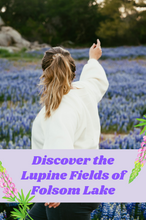Add these amazing Lupine blooms near Sacramento to your California wildflower bucket list!
What is Lupine:
Lupine or Lupin is a flowering plant in the legume (Fabaceae) family - yes that means they are correlated to the same species that beans and peas come from! This rapidly growing wildflower is commonly found living in the Western United States and is cultivated as a food source and ornamental flower. Large fields of lupine are also popularly photographed in New Zealand but are controversial as this invasive and non-native species is an environmental threat to the native flowers that grow there.
There are over 200 different species of lupine and they can range in size, color, and lifespan. Some lupine grow ankle high while some of the largest grow to be up to 5 feet tall! They are typically a blue or purple color but can also grow in white, yellow and red.
How Do you Pronounce Lupine:
According to Merriam Webster Lupine is pronounced (Loo-Pine) but botanists prefer to say Lupin (Loo-Pin). Either spelling and pronunciation of this flower is fine - although what is more fascinating about this word is its origins. The term Lupine comes from 'Lupus' which in Latin translates to "Wolf" - the flower got it's name back in the Roman ages! The Romans noticed that these flowers were invading fields and dry water beds - which led them to believe that this rapid growth was "wolfing" down the soil. Although they thought this was a negative, this flower was actually providing nitrogen to the soil and adding back nutrients to the land.
When is Lupine Season in California:
California Lupine Wildflowers are a short lived annual/perennial flower that blooms in early Spring (March) and die off by late Spring (June). As of 2021 the lupine wildflowers in California have begun to flourish in Mid April and should hopefully last until June.
Where to Find Lupine in California:
Lupine tends to grow on slopes or on open disturbed areas and is natively found in California, Oregon and Nevada. It grows along the coast, foothills of the Sierras, and into the mountains - taking over meadows, forest clearings and hillsides.
Some of the most spectacular lupine blooms can be found at Folsom Lake State Recreation Area - just within an hour from Sacramento, California. To find the lupine fields of Folsom Lake you will want to park at Beeks Bight Parking Lot - note parking fills up very fast especially the hour before sunset!
Folsom Lake State Park is about 25 miles east of Sacramento and is a very popular area for hikers, bikers and outdoor enthusiasts. Park admission fees range from $5 - $12 depending on which entrance you enter from. Parking near the lupine fields was a $12 admission fee at the Folsom Lake- Granite Bay entrance.
Once you've parked at Beeks Bight or in any of the smaller lots nearby - you can head down a small and short trail down by the lake and you will be engulfed in fields of thousands of lupine flowers! The flowers grow all along the dry lake bed and slope-sides and there is plenty of room to find a secluded spot to take photographs.

Tips for Visiting + Photographing Lupine:
Photographing the lupine fields at Folsom Lake should definitely make it to your California Wildflower bucket list! Although there were already an abundance of people taking photos here we still were able to wander around and find spots to ourselves to take photos!
Here are some of my tips for photographing + visiting the Lupine Fields:
Get Low! These miniature lupines are only ankle high so you will want to try posing yourself lower to the ground to have a more dramatic effect.
Surround Yourself! You will be able to find dry spots or flattened areas in between the flower fields to sit and take photos. Of course take caution to not trample the flowers while finding these areas but the photos look absolutely magical when you are surrounded on all sides!
Framing! Now that you've found your spot - have your photographer get low and use the lupine in the foreground to frame your shot. Also have fun with it and try all different types of angles and composition!
Find a Slope! Using the hillside to take photos will help you make the lupines appear larger.
Watch out for Prickly Balls! I took my shoes off to be more comfortable but quickly discovered there are brown prickly stickers on the ground - which also can be uncomfortable if sitting on one! Be aware of these sticklers and keep an eye on the kiddos.
Take Allergy Medicine If you get bad allergies during the Spring you might consider taking some the day of. Wouldn't want a runny nose and red eyes to ruin your pictures!
SHOP MY LOOKS
Human Kind T-Shirt: https://bit.ly/3nbtjzO
California Flowers Sweatshirt: https://bit.ly/32DXs1f
Ruffled Midi Tie Belt Wrap Dress: https://bit.ly/3dEC6r0
I hope you liked this blog on Wild Growing Lupine in California! Please Pin + Share! :) Follow me on Instagram at @brittsbellavita for Hidden Gems + California Travel Inspiration.
















